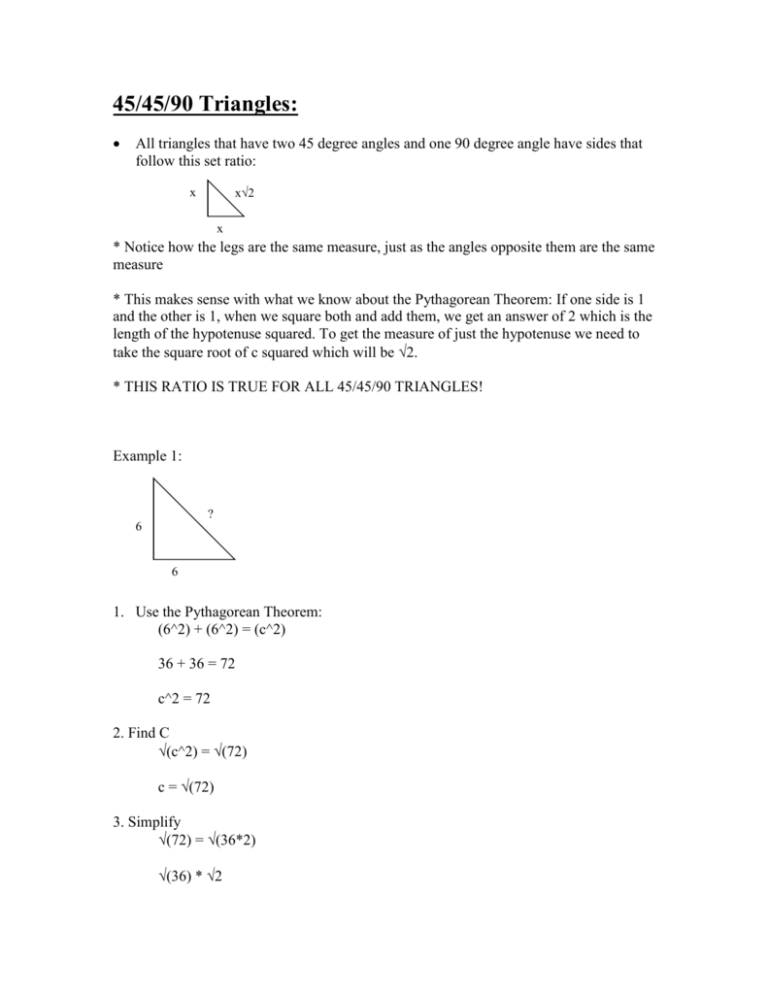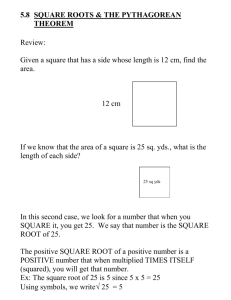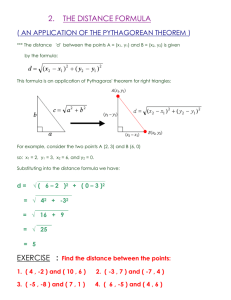45/45/90 Triangles - edu221fall09class
advertisement

45/45/90 Triangles: All triangles that have two 45 degree angles and one 90 degree angle have sides that follow this set ratio: x x2 x * Notice how the legs are the same measure, just as the angles opposite them are the same measure * This makes sense with what we know about the Pythagorean Theorem: If one side is 1 and the other is 1, when we square both and add them, we get an answer of 2 which is the length of the hypotenuse squared. To get the measure of just the hypotenuse we need to take the square root of c squared which will be 2. * THIS RATIO IS TRUE FOR ALL 45/45/90 TRIANGLES! Example 1: ? 6 6 1. Use the Pythagorean Theorem: (6^2) + (6^2) = (c^2) 36 + 36 = 72 c^2 = 72 2. Find C (c^2) = (72) c = (72) 3. Simplify (72) = (36*2) (36) * 2 6*2 We have just proven that in a 45/45/90 triangle, the length of the hypotenuse is equal to the length of the sides times 2 Example 2: ? 20 20 1. Use the Pythagorean Theorem. (20^2) + (20^2) = (c^2) 400 + 400 = 800 (c^2) = 800 2. Find C (c^2) = (800) c = (800) 3. Simplify. (800) = (400*2) (400) * (2) 20*2 Example 3: 18 ? 18 1. Use the Pythagorean Theorem. (18^2) + (18^2) = (c^2) 324 + 324 = (c^2) 648 = (c^2) 2. Find C (c^2) = 648 (c^2) = (648) c = (648) 3. Simplify. (648) = (324*3) (324) *(2) 18*(2) What if we were only given the length of the hypotenuse? Example 1: 288 1. Do the reverse Pythagorean Theorem (instead of solving for c, we’re now solving for a and b) -- (a^2) + (b^2) = (c^2) Solve for a: -- (a^2) = (c^2) – (b^2) Solve for b: -- (b^2) = (c^2) – (b^2) *NOTE: in a 45/45/90, the legs are the same, thus a=b so the Pythagorean Theorem becomes 2(a^2) = (c^2). 2(a^2) = (c^2) 2(a^2) = 288 *We’re solving for a. What’s the first thing that needs to be removed from it? The multiplication. How do we do that? Divide both sides by 2. Now we’re left with (a^2) = 144 (a^2) = (144) a = 12. Example 2: 72 1. Reverse Pythagorean Theorem 2(a^2) = (c^2) 2(a^2) = 72 Divide both sides by 2 (a^2) = 36 (a^2) = (36) a=6 30/60/90 Triangles: * All triangles that have one 30 degree angle, one 60 degree angle and one 90 degree angle have sides whose measures follow the set ratio: 2x x x3 *Note: “x” is the smallest value in this ratio (this can be determined by examining the coefficents for each side, the coeffiecent for “x” is 1, the coefficent for “2x” is 2, and the coefficent for “x3” is 3. Of these values, 1 is the smallest) which is directly opposite of the smallest angle (the 30 degree angle). Likewise, the largest side is opposite the largest angle (2x is opposite 90). *This makes sense with what we know about the Pythagorean Theorem. If the small side is 1, and the other side is 3, then (1^2) + ((3)^2) = (1+3) which means that (c^2) = 4, thus c = 2. *THIS RATIO IS TRUE FOR ALL 30/60/90 TRIANGLES! Example: 1. Find the missing sides ? 3 ? 2. When refering back to the ratio, we can tell that the hypotenuse will be 2 times the smallest side. This means the hypotenuse will be 2*3 or 6. 3. When referring back to the ratio, we can tell that the second leg will be 3 times the smallest side. This means the hypotenuse will be 3*3 or 5.19 (*PLEASE DO NOT PUT IN DECIMAL FORM*) Example 2: 34 ? ? 1. Refer to the ratio. 2. By referring to the ratio, we can tell that the hypotenuse is two times the smallest side. This means the smallest side will be equal to ½ the hypotenuse or 17. 3. By referring to the ratio, we can tell that the measure of the second leg is 3 times the smallest side. This means the second leg is equal to 173. Example 3: ? ? 27 1. Refer to the ratio. 2. By referring to the ratio, we can conclude that the length of the second side is equal to the size of the smallest times 3. This means that 27 = a3. -- Solve for a. 27 = a3 * Divide both sizes by 3 a = (27/3) 3. By referring to the ratio, we can conclude that the hypotenuse is 2 times the length of the smallest side “a”. This means that the hypotenuse is 2(27/3) or (54/3).







